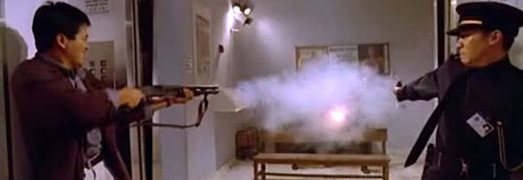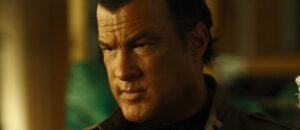When did action movies change from being classically shot and aware of space and geography, to all this frantic half-second editing and shaky-cam nonsense? A fascinating two-part video essay tries to answer that question.
I frequent Jim Emerson’s Scanners blog. Recently, he had a great piece that highlighted a well-reasoned, well-constructed video essay about the state of modern action cinema. Film scholar Matthias Stork nicknames it “Chaos Cinema,” and for good reason. So many action movies today feature hyperactive editing and full-blown climactic plateaus of action that never come down for a breath. Scenes in many of today’s films seem to eschew spatial geography, and never let the viewer become aware of the scene’s surroundings. Instead, quick cuts and lazy camerawork paste together hyper-aggressive sequences of whizzing bullets and flailing bodies.
Stork’s video essay is perhaps the best explanation of today’s Chaos Cinema I’ve ever seen. He seamlessly compares recent movies like ‘Bad Boys II‘ and ‘Transformers‘ to well-constructed action scenes from ‘Die Hard‘ and ‘Hard Boiled‘.
Chaos Cinema Part 1 from Matthias Stork on Vimeo.
The most telling part in the first half of the essay is when Stork compares the famous gun battle in ‘Hard Boiled’ to the insanely unintelligible action movies of today. That elaborately choreographed sequence is infinitely more enjoyable than the indistinguishable bodies and bullets flying around in something like ‘Battle: Los Angeles‘. Notice the ways in which understanding the character’s surroundings allows you to be more immersed in the scene. Action directors nowadays mistake the shaky-cam effect as some sort of intimate filmmaking tool. They think that by shaking the camera around enough, the audience will believe that the scene is more real than the classical style of filming.
That ‘Hard Boiled’ clip is a perfect example of a well-constructed, well-staged action scene. The scene draws you in with its realistic portrayal of spatial geography. It’s a scene that knows that pausing for dramatic effect isn’t a bad thing. There are no pauses in today’s action cinema. There’s no time for the audience to catch its bearings. By the time we do, the scene is over.
Michael Bay’s ‘Transformers’ movies are this way. Bay never builds up to a climax. Instead, his movies feature hyper-kinetic scenes chock full of climatic action right up until the end. This is indeed what Stork means by Chaos Cinema, and as he says it’s a “perversion.”
Prachya Pinkaew’s ‘The Protector‘ is a fantastic example of what you can achieve with a not-so-simple tracking shot.
Why is it that when we see a shot like this we’re automatically surprised? I would submit that we’ve become so accustomed to watching today’s attention deficient cinema that a tracking shot of this caliber makes us simply stare in amazement. In reality, more action movies should embrace this style of filmmaking.
Chaos Cinema Part 2 from Matthias Stork on Vimeo.
In Stork’s second piece, he points out an immutable truth that we seem to forget whenever the camera is swinging around wildly. If we have a hyperactive camera and insane editing, we miss out on the nuanced performances of the actors. It’s impossible to see the actors react to situations when the frenzied action overtakes them and the camera ignores them. How often do we get to see an actor’s subtle facial movements when the camera undulates without any rhyme or reason?
I adore how Stork compares the absurdly edited ‘Quantum of Solace‘ to a much more beautiful car chase in ‘Ronin‘. It seems that the staging of these special scenes has all but become extinct.
One thing I really find interesting is Stork’s explanation of how audio mixes have become more intricate and precise to compensate for the visual action. However, it would seem that some soundtracks are just as overbearing – especially when knives and sword blades create a “Shiiiiing” sound just from flying through empty air.
Call me a snooty critic if you want, but I like to understand where the characters are in space and time. For me, it adds to the excitement if I know exactly where the bad guys are relative to the good guys. What do you think of the state of modern action cinema? Are you a fan of Chaos Cinema or do you prefer the classical approach?





JoeRo
Nice post Aaron, this “chaos cinema” trend is something my friends and I have been lamenting for some time. I honestly blame Saving Private Ryan for the popularity of shaky cam, but I should add that this isn’t a slam on that movie (although it’s not one of my favorites). Ryan was the first to employ, in my mind at least, that sort of frenetic shaky cam action that’s so commonplace today. That movie was also very successful. The look of war movies changed after Ryan, and a lot of other action movies have borrowed that one film element to look “realistic”.
I think Stork is right to bring up Hong Kong cinema in the first film as it provides the most obvious contrast between visual styles (again from my prospective). Like many others I remember watching Bruce Lee and Jackie Chan movies while I was growing up. It’s amazing how much their films, John Woo’s as well, allow you to follow the action without losing your bearings. This is something very important in Chan’s films considering the nature of his physical comedy. If Chan’s movies were shot like modern action movies, a major component of his specific brand of humor would be lost … and that would be sad.
I’d really like to see this trend end immediately, but I’m hopeful that it’s just an aesthetic fad that we’ll look back on in ten years as a curiosity.
Also gotta give Stork credit here for coining the term “promiscuous camera movement”.
Aaron Peck
AuthorAlso “shotgun aesthetic” was a great phrase.
Rian Moseley
That’s actually one of the reasons I dont like Savying Private Ryan is the Shaky Cam Action Sequences, I much prefer The Thin Red Line in that regard but that got overshadowed by savying private ryan coming out in the same year. Oh well shaky cam wins!
RollTide1017
Saving Private Ryan did used a shaky cam but, the action scene are still classicly staged. I’m never lost or struggle to see what is happening in Saving Private Ryan, unlike most action films today.
I hate that car chase in QOS. I remember think “what just happened” after the chase was over when I saw it in theaters.
I know there are a lot of Avatar haters around here but, this is one reason I love the movie so much. Cameron still, mostly, used his old style of shooting action and it was a great change of pace from typical action movies made these days. Cameron is still one of the best at filming action scenes and, I wish more filmmakers would copy him and not Bay.
Dail Whiteley
great write up.
EM
Uh-oh, another blog entry with a negative mention of Michael Bay. Obviously the Bonus View is relentlessly pursuing an evil agenda. 😛
Jane Morgan
For the most part, I see Chaos Cinema as an evolution of the art form. It feels more honest.
Watching the classics, Die Hard, Hard Boiled, Ronin, the choreography looks too staged. Too slow. Too much like puppets on a set.
Watching the chaos, Bad Boys, Quantum, Bourne, feels thrilling. Like what the emotion of that moment would actually feel like.
That said, between the two styles, I prefer a compromise. Controlled Chaos. Which I think is always the goal, but sometimes, constrained by budget and time, a film can easily slip away from the director’s intent.
‘The Raid’ looks to be a perfect example of pure Controlled Chaos.
But what bothers me the most in modern action movies is the constant uncanny-valley effect of poorly-integrated CGI. i.e. Captain America.
To be immersive, special effects and camera work need to be invisible.
paramedic0112
I think what people are trying to accomplish with the shaky cam is to make the scene “gritty.” Action in real life does happen fast as Jane said, but there is a way to show that in a way that allows the scene to breath a bit and gives the viewer perspective. I thought the action in No Country for Old Men and Drive both do a great job at being realistic and gritty, while also allowing the viewer to see exactly what the heck is going on. I have to say that the car chases in Ronin are some of the best ever made. Up there with The French Connection, The Seven Ups, and Bullit. I thought the car chase in Drive was excellent as well and that’s a movie that came out this year!
Jane Morgan
Fellini breaks the laws of drama and is praised.
Greengrass breaks the laws of spacial geography and it’s a crime against cinema?
Maybe Chaos Cinema is the current growing pains of the genre, and these experimentations are crucial to the continued evolution of the art form.
Dail Whiteley
i think its in the hands of the storyteller. one of the problems i have with the bourne films is when there is an action scene it’s just action. theres no story going on , the action slows down the pacing of a very flat story when it should help it. my all time favorite scene is in my all time favorite movie raiders of the lost ark. the ark chase scene , if you go back and watch it , every frame is moving the story forward. with chaos you just have chaos and nothing else.
Dimwit
Blame Doug Liman. While a master, he made it look too easy and was very effective with the first Bourne.
Another thing is not the shaky Steadicam which allows the scene to be potentially more immersive but doing it with closeups. That is the killer. With no master shots or establishing focii the scenes lose any sense of relevance. You don’t know where you are, who to focus on or what action to follow. It’s also a cop out for cheap flix that expect motion to mask script and acting issues and set shortcomings.
One of the great things about that hospital scene by Woo is that it’s one set. Those are doors moved by grips and they change the complete set while Yun Fat waits behind those doors. Amazing!
tim racca
this is by far the best dialog i’ve found about shaky-cam/chaos cinema. it may very well be the evolution of the art form but for my price of admission, shaky-cam is just not fun to look at. it seemed to really get momentum after blair witch and i started keeping stats on what movies were shot properly vs. the lazy, hand-held method. as of 3 yrs ago, i gave up on cinema entirely, feeling as though the film-making world was matching the theme of mike judge’s “idiocracy”. 3 oscar-winners in a row were largely shot hand-held and intentionally shaky. wtf. after reading everyone’s prior comments i feel like testing the movie-watching water again. there’s that hope and change thing again. i’m genuinely glad.